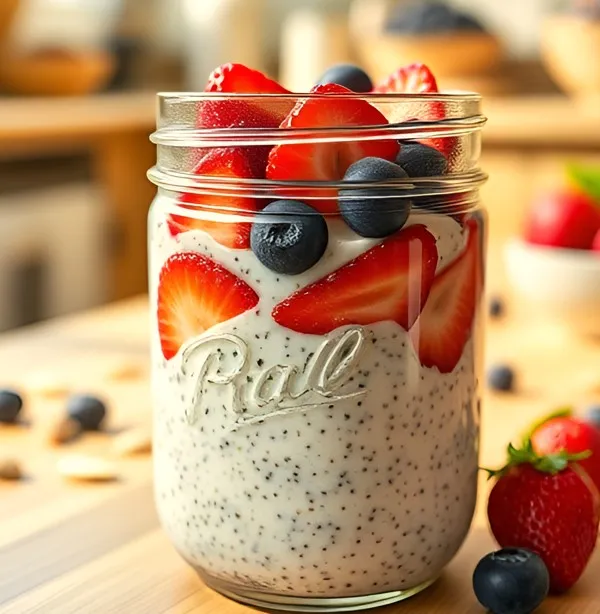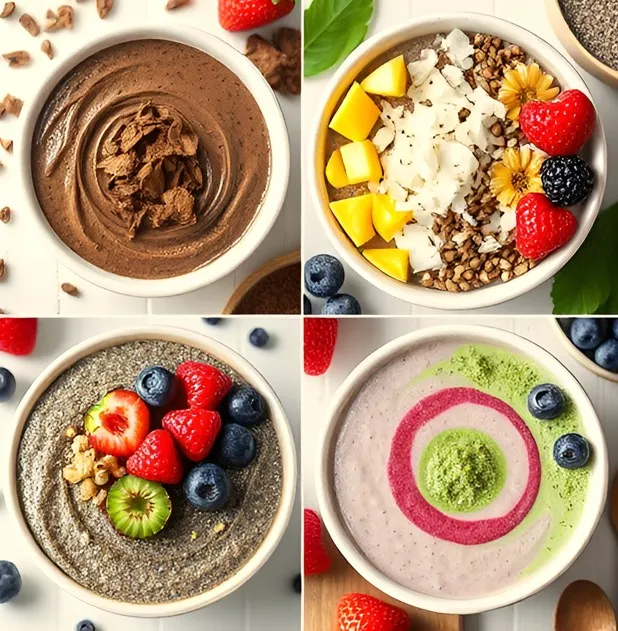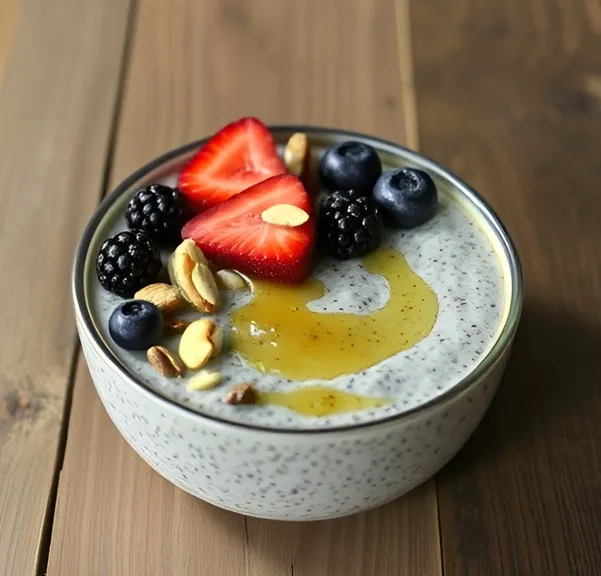The Protein Powerhouse: Chia Seeds
While chia seeds are renowned for their rich omega-3 fatty acid content, they are also a significant source of plant-based protein. Protein is essential for numerous bodily functions, including muscle repair, immune system support, and hormone production. Incorporating chia seeds into your diet can help meet your daily protein requirements, especially for those following vegetarian or vegan diets.
One of the standout features of chia seeds is their comprehensive amino acid profile. Unlike some other plant-based proteins that lack certain essential amino acids, chia seeds provide a balanced array, making them a complete protein source. This makes chia seed pudding not just a tasty treat but also a nutritious addition to your meals
Table of Contents
Crafting the Perfect Chia Seed Pudding
Creating chia seed pudding is a straightforward process that requires only a few ingredients. Here’s a basic recipe to get you started:
Ingredients:
- 3 tablespoons of chia seeds
- 1 cup of milk (dairy or plant-based)
- 1 tablespoon of sweetener (honey, maple syrup, or agave nectar)
- 1 teaspoon of vanilla extract
- Toppings of your choice (fresh fruits, nuts, seeds, etc.)
Instructions:
- In a mixing bowl or mason jar, combine the chia seeds, milk, sweetener, and vanilla extract.
- Stir well to ensure the chia seeds are evenly distributed and not clumping together.
- Cover and refrigerate for at least 4 hours or overnight. This allows the chia seeds to absorb the liquid and swell, creating a pudding-like consistency.
- Before serving, give the pudding a good stir. Add your favorite toppings and enjoy!
This basic recipe serves as a blank canvas, allowing you to experiment with different flavors and add-ins to suit your palate.

Enhancing Protein Content in Chia Seed Pudding
While chia seeds themselves are a good source of protein, you might want to boost the protein content of your pudding for added benefits. Here are some creative ways to increase the protein content:
1. Use Protein-Rich Milk Alternatives: Opt for milk alternatives that are fortified with protein. Options like soy milk, pea protein milk, or almond milk blended with additional protein can significantly enhance the protein content of your pudding.
2. Incorporate Protein Powder: Adding a scoop of your favorite protein powder can effortlessly increase the protein content. Choose flavors that complement your pudding, such as vanilla, chocolate, or unflavored protein powders.
3. Mix in Nut Butter: Stirring in a tablespoon of almond butter, peanut butter, or cashew butter adds not only protein but also healthy fats and a rich flavor to your pudding.
4. Add Greek Yogurt: For those who consume dairy, incorporating Greek yogurt can be an excellent way to boost protein levels. It also adds a creamy texture to the pudding.
5. Top with Nuts and Seeds: Enhancing your pudding with chia seeds is already a great start, but adding other nuts and seeds like almonds, walnuts, or hemp seeds can further increase the protein content while adding a delightful crunch.
By implementing these additions, you can tailor your chia seed pudding to meet your specific protein needs, making it an even more substantial and satisfying meal or snack.
Nutritional Breakdown of Chia Seed Pudding
Understanding the nutritional value of your meals is crucial for maintaining a balanced diet. Here’s a general overview of the nutritional content you can expect from a basic chia seed pudding:
- Calories: Approximately 200-250 calories per serving, depending on the ingredients used.
- Protein: Around 6 grams from chia seeds alone. This can increase to 15 grams or more with added protein sources like protein powder or Greek yogurt.
- Fiber: Chia seeds are rich in fiber, providing about 10 grams per serving, aiding in digestion and promoting a feeling of fullness.
- Omega-3 Fatty Acids: Chia seeds are an excellent source, offering about 5 grams per serving, which is beneficial for heart health.
- Vitamins and Minerals: Chia seeds contain essential nutrients like calcium, magnesium, and iron.
By customizing your pudding with protein-rich ingredients, you can enhance its nutritional profile to better align with your dietary goals.
Benefits of Regularly Consuming Chia Seed Pudding
Incorporating chia seed pudding into your daily diet offers numerous health benefits:
1. Enhanced Digestive Health: The high fiber content in chia seeds promotes healthy digestion, prevents constipation, and supports a healthy gut microbiome.
2. Sustained Energy Levels: Chia seeds provide a steady release of energy, making chia seed pudding an excellent option for breakfast or a midday snack to keep you energized throughout the day.
3. Weight Management: The combination of fiber and protein in chia seed pudding contributes to a feeling of fullness, helping to curb overeating and support weight management efforts.
4. Heart Health: Rich in omega-3 fatty acids, chia seeds help reduce inflammation, lower cholesterol levels, and support overall cardiovascular health.
5. Bone Health: Chia seeds are a good source of calcium, magnesium, and phosphorus, all of which are vital for maintaining strong and healthy bones.
6. Blood Sugar Regulation: The fiber and protein in chia seed pudding help stabilize blood sugar levels, making it a beneficial choice for individuals managing diabetes or insulin resistance.
By enjoying chia seed pudding regularly, you can reap these health benefits while indulging in a delicious and satisfying treat.
Frequently Asked Questions (F.A.Q.)
Are chia seeds high in protein?
Yes, chia seeds are considered a good source of plant-based protein. Two tablespoons of chia seeds contain approximately 4 grams of protein. While they may not provide as much protein as animal-based sources, their inclusion in meals like chia seed pudding can contribute to your daily protein intake, especially when combined with other protein-rich ingredients.
What to add to chia seed pudding for protein?
To boost the protein content of your chia seed pudding, consider adding:
- Protein Powder: Choose your preferred flavor and mix it into the pudding base.
- Greek Yogurt: Adds creaminess and an extra protein punch.
- Nut Butters: Peanut, almond, or cashew butter can enhance both flavor and protein levels.
- Milk Alternatives: Use soy milk or other protein-fortified plant-based milks.
- Nuts and Seeds: Toppings like almonds, walnuts, or hemp seeds add additional protein and texture.
How much protein is in 2 spoons of chia seeds?
Two tablespoons of chia seeds contain approximately 4 grams of protein. This amount can vary slightly based on the brand and specific type of chia seeds used.
Is it OK to eat chia seed pudding every day?
Yes, consuming chia seed pudding daily can be part of a healthy diet. Chia seeds offer numerous health benefits, including high fiber and omega-3 content. However, it’s essential to maintain a balanced diet by incorporating a variety of other nutrient-rich foods. Additionally, due to the high fiber content, it’s advisable to drink plenty of water to aid digestion and prevent any potential digestive discomfort.
Creative Variations of Chia Seed Pudding
One of the joys of chia seed pudding lies in its versatility. Here are some creative variations to keep your taste buds excited:
1. Chocolate Chia Seed Pudding: Add cocoa powder or melted dark chocolate to your pudding base for a rich, chocolatey flavor. Sweeten with a bit of maple syrup or honey for a decadent treat.
2. Tropical Paradise: Incorporate mango puree, coconut milk, and shredded coconut to create a tropical-inspired pudding that’s both refreshing and satisfying.
3. Berry Bliss: Mix in a variety of berries like strawberries, blueberries, and raspberries. Top with fresh fruit and a sprinkle of chia seeds for added texture.
4. Matcha Green Tea: Add matcha powder to your pudding for a unique flavor and an antioxidant boost. This variation is perfect for tea lovers seeking something different.
5. Spiced Chai: Infuse your pudding with chai spices like cinnamon, cardamom, and ginger. This warming flavor profile is ideal for fall and winter months.
6. Peanut Butter Banana: Combine banana slices and a generous spoonful of peanut butter into your pudding for a classic and beloved flavor combination.
7. Lemon Blueberry: Add lemon zest and blueberry puree for a zesty and fruity pudding that’s both tangy and sweet.
These variations not only add exciting flavors but also introduce additional nutrients and textures, keeping your chia seed pudding experience delightful and diverse.

Storage and Preservation
Proper storage ensures that your chia seed pudding remains fresh and delicious. Here are some tips for preserving your pudding:
- Refrigeration: Chia seed pudding can be stored in the refrigerator for up to five days. Ensure it is kept in an airtight container to maintain freshness.
- Freezing: Although not necessary for most, chia seed pudding can be frozen for longer storage. Freeze in individual portions and thaw in the refrigerator when ready to consume.
- Avoid Over-Mixing: When preparing your pudding, stir it well initially to prevent clumping. However, avoid over-mixing after it has set, as this can break down the chia seeds and alter the texture.
By following these storage guidelines, you can enjoy your chia seed pudding at its best over several days.
Incorporating Chia Seed Pudding into Your Daily Routine
Chia seed pudding’s flexibility makes it easy to incorporate into various meals and snacks. Here are some ideas on how to include it in your daily diet:
1. Breakfast Boost: Start your day with a nutrient-packed chia seed pudding topped with fresh fruits and nuts. It provides sustained energy to keep you going until your next meal.
2. Mid-Morning Snack: Enjoy a small portion of chia seed pudding as a snack to curb hunger pangs and maintain your energy levels throughout the day.
3. Pre-Workout Fuel: Consume chia seed pudding before exercising to fuel your body with protein and healthy fats, helping to enhance your workout performance.
4. Post-Workout Recovery: After a workout, chia seed pudding can aid in muscle recovery with its protein content and replenish lost nutrients.
5. Dessert Alternative: Treat yourself to a healthier dessert option by preparing a sweet chia seed pudding variation, satisfying your sweet tooth without the guilt.
6. On-the-Go Option: Prepare individual servings of chia seed pudding in mason jars or portable containers for a convenient and nutritious option when you’re busy or traveling.
By integrating chia seed pudding into different parts of your day, you can enjoy its benefits consistently while adding variety to your meals.
Potential Downsides and Considerations
While chia seed pudding is generally safe and beneficial for most people, it’s essential to be aware of certain considerations:
1. High Fiber Content: Chia seeds are rich in fiber, which is excellent for digestion. However, excessive consumption can lead to digestive discomfort, such as bloating or gas, especially for those unaccustomed to high-fiber diets. It’s advisable to start with smaller portions and gradually increase intake as your body adjusts.
2. Caloric Intake: Depending on the ingredients used, chia seed pudding can be calorie-dense. Monitoring portion sizes and being mindful of added sweeteners and toppings can help manage caloric intake, especially for those aiming for weight loss.
3. Allergies: Individuals with allergies to seeds or nuts should exercise caution when preparing chia seed pudding, particularly when adding nut-based toppings or flavors.
4. Blood Thinning: Chia seeds contain omega-3 fatty acids, which have blood-thinning properties. While beneficial for heart health, individuals on blood-thinning medications should consult with a healthcare professional before significantly increasing their chia seed intake.
5. Interaction with Medications: Due to their high fiber content, chia seeds can affect the absorption of certain medications. It’s advisable to consume chia seed pudding at least a few hours apart from taking medications.
Being aware of these considerations ensures that you can enjoy chia seed pudding safely and effectively as part of a balanced diet.
Conclusion
Chia seed pudding stands out as a versatile, nutritious, and delicious option for those seeking to enhance their diet with plant-based proteins and essential nutrients. Its ease of preparation, coupled with endless customization possibilities, makes it a staple in many healthy eating routines.
By understanding its nutritional benefits, creative variations, and how to incorporate it into daily meals, you can fully harness the potential of chia seed pudding. Whether you’re aiming for increased protein intake, improved digestive health, or simply a tasty and satisfying meal, chia seed pudding delivers on all fronts.

